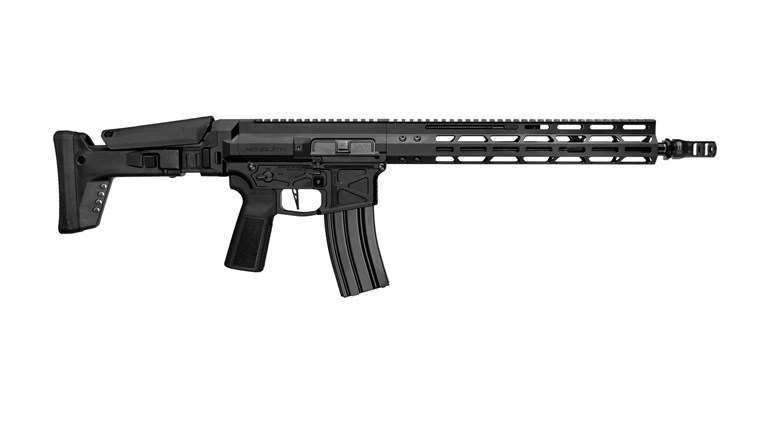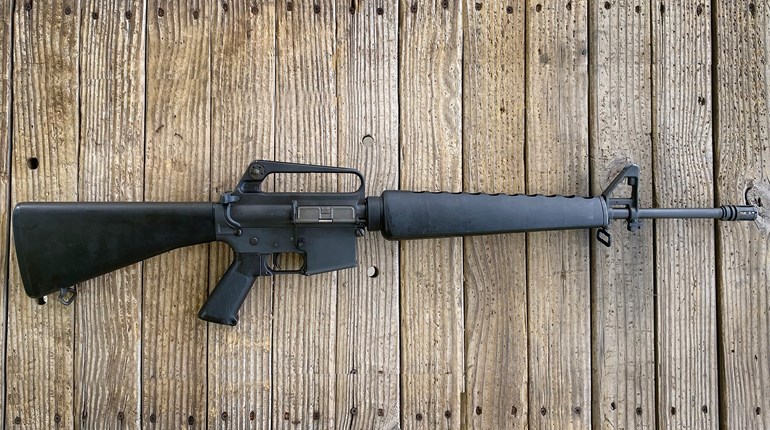
Fabrique Nationale, through its U.S. subsidiary FNH-USA, is offering one of the most modern, innovative and frankly atypical applications of the "bullpup" design in its FS2000 rifle—a semi-automatic-only variant of the company's F2000 select-fire rifle.
Chambered in 5.56x45 mm (.223 Rem.) and designed to feed from AR-15/M16 magazines, the gas piston-driven FS2000 was first introduced to the U.S. market in 2006 in a "Tactical" configuration sporting a green stock and a flat top with a polymer M1913 Picatinny rail on its open, flat-topped receiver (which FNH-USA terms the "barrel support assembly"). However, FNH-USA is now offering a new variant—the FS2000 Standard—that more closely approximates the looks and configuration of the original F2000.
Unlike the green-stocked FS2000 Tactical, the FS2000 Standard sports a sleek all-black exterior. The color is not the only significant change. Similar to the F2000, the Standard also features a built-in 1.6X optic attached to its Picatinny rail and concealed by a polymer cover, which features a 15 mm objective lens diameter and a German-style reticle. To supplement the integral optic, the polymer cover assembly has a set of rudimentary notch-and-post back-up sights molded directly into the top.
The FS2000 Standard features modern materials and manufacture, with a tough polymer stock and an aluminum receiver. The rifle's bolt, barrel and a barrel-extension into which the bolt locks are all steel. The 171⁄2-inch barrel has a 1:7 rate-of-twist and features a permanently attached muzzle brake. A modular fire-control assembly, made primarily of polymer, is located inside the butt of rifle's stock and is easily removable.
Another unique feature of the FS2000 is its inspection cover door located to the rear of the optics cover assembly. Since the action and chamber are completely enclosed within the rifle's stock assembly, this door allows visual access to the chamber area.
One of the most unique qualities of the FS2000 is it's almost entirely ambidextrous. An Achilles' heel of most bullpup designs—particularly for southpaws—is having the action of the rifle located behind the trigger, the ejection port is then in the rifle's buttstock near the shooter's face. FN's solution was novel—a forward ejection system that employs a tube above the barrel and an ejection port on the upper right side of the receiver, covered by a hinged synthetic door.
When the FS2000 is fired, gas pressure tapped through a port in the barrel drives the rifle's short-stroke gas piston rearward, pushing back the bolt carrier assembly. This piston system employs a two-position regulator plug with two settings: normal for standard ammunition and adverse for allowing more gas in for when the system might be fouled. During the gas piston's rearward stroke, the bolt carrier assembly's rearward movement rotates and unlocks the six-lugged bolt from the barrel extension, beginning the process of extracting the fired case. During this movement, the extractor pulls away from the case and the ejector moves the case up into a plastic part FNH-USA terms the "rifle's switch," which receives the fired case and aligns it with the ejection tube.
This process is continued for five or six rounds until the ejection tube isfilled with empty cases. At this point, the pressure of the next fired case entering the tube forces the ejection-port cover open and allows them to be ejected. If the rifle is fired fewer times, the door can be opened manually and the rifle tipped down to empty the ejection tube. The result is a rifle that does not externally eject cases until the fifth or sixth round, as well as one that can be used just as easily by a lefty as by a right hander.
To further enhance the ambidextrous nature of the design, the FS2000 employs a disc-shaped safety in the lower, forward section inside the triggerguard. A clock-wise rotation places the rifle off safe, while a counter-clockwise turn places in on. An ambidextrous magazine release is located just forward of the magazine well and is pushed up to release the magazine. The only non-ambidextrous feature of the rifle is its charging handle, located on the upper left side of the receiver.
The fit and finish of the test rifle received was excellent, and all controls worked as designed. Although eccentric in appearance, the ergonomic qualities of the Standard FS2000 were quite good, with excellent balance. In addition, the integral optic was easy to use and very clear. For handling and shooting, I fitted the rifle out with an ambidextrous Urban-Sentry hybrid sling, which is convertible to either single-point or two-point configuration.
I tested the rifle with a selection of Remington, Federal and Black Hills ammunition. There were no malfunctions during testing and the rifle performed quite well. In fact, accuracy results were good considering the use of the low-powered 1.6X optic and a not particularly crisp trigger break (a common feature of bullpup rifles due to long trigger linkage).
Although by no means inexpensive, the FS2000 Standard offers civilian shooters a unique opportunity to own a cutting-edge firearm design that takes advantage of modern technology and materials. It's also simply a blast to shoot.




































